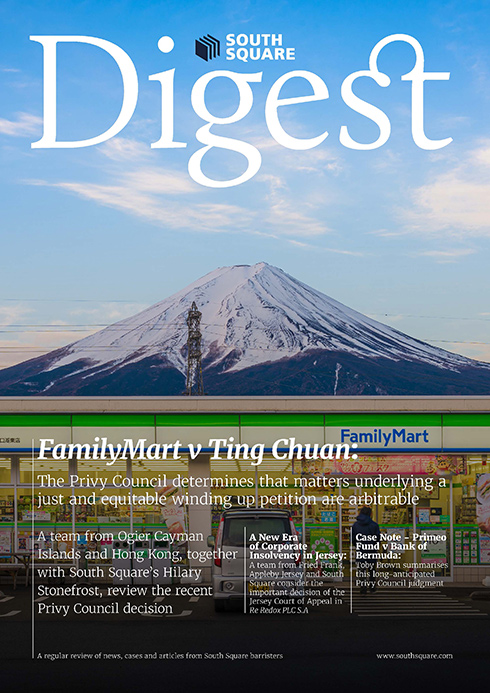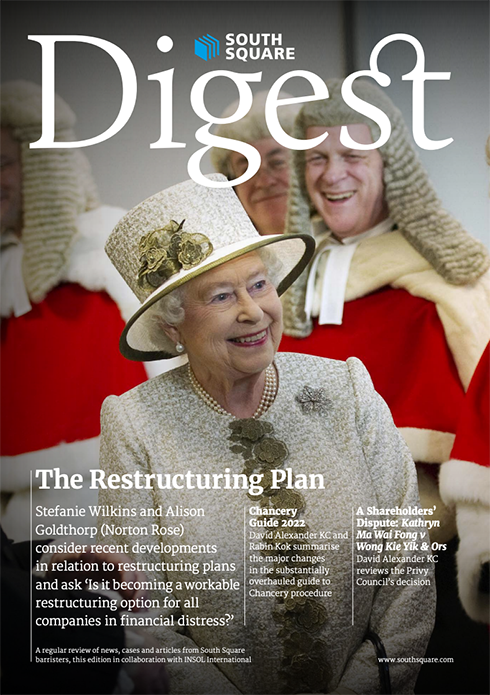

“Jarndyce and Jarndyce has passed into a joke. That is the only good that has ever come of it.
It has been death to many, but it is a joke in the profession. Every master in Chancery has had a reference out of it. Every Chancellor was “in it”, for somebody or other, when he was counsel at the bar. Good things have been said about it by blue-nosed, bulbous-shoed old benchers in select port-wine committee after dinner in hall. Articled clerks have been in the habit of fleshing their legal wit upon
- The last Lord Chancellor handled it neatly, when, correcting Mr. Blowers, the eminent silk gown who said that such a thing might happen when the sky rained potatoes, he observed, “or when we get through Jarndyce and Jarndyce, Mr. Blowers”—a pleasantry that particularly tickled the maces, bags, and purses” CHARLES DICKENS, BLEAK HOUSE
A. Introduction
Say the word ‘chancery’ and the action in Jarndyce v Jarndyce is the first thing that comes to mind of many a member of the public, and perhaps many an English, Welsh, offshore or Commonwealth lawyer. Thankfully, ‘the modern Chancery Division’ is no longer an oxymoron. The Chancery Division is now part of the Business and Property Courts and is a vitally important national institution, as well as an international commercial court in which businessmen from all over the world plead their case.
Chancery procedure was modernised, in recent times, by the Civil Procedure Rules 1999, in 2016 by the creation of the last version of the Chancery Guide tailored to the needs of chancery judges and litigants. In 2019, the Disclosure Pilot was introduced in the Business & Property Courts to reduce the cost of and time taken in standard disclosure. The Pilot, whose rules are contained in CPR 51U, were extended to the Insolvency and Companies Court (ICC) in February 2019 and will be made permanent in the Business and Property Courts (BP&Cs) from 1 October 2022 as PD 57AD.
The Chancery Guide 2022 is the latest evolution of Chancery procedure. The Chancery Guide 2016 was amended several times since being issued, but the 2022 Guide is the first complete re-write in six years.
It is a re-write that rises to meet the challenges of a world that is all too different from Dickens’ world, and from the world that all of us thought that we knew.
The 2022 Guide contains several features of note that are aimed at these challenges and the significant changes in English & Welsh civil procedure since 2016. It is the first digital edition of the Guide, in the sense that it is fully hyperlinked – it is hyperlinked internally as well as to relevant provisions of the CPR, Practice Directions, District Registry Guidance and to legislation. It introduces a brand-new Protocol governing remote hearings in Appendix Z. It is updated with references to the relevant provisions of the Disclosure Pilot.
It provides guidance on electronic bundles. These are to be the only type of bundle filed going forward, unless the judge requests otherwise, as paragraph 1 of Appendix X states.
Finally, the procedural and case management guidance in the 2022 Guide has been significantly rewritten to be brought in line with the provisions of the Commercial Court Guide and the TCC Guide, in an effort to streamline and unite practice across the BP&Cs.
We could not possibly cover in this short briefing all of the changes, or even all of the important changes in the 2022 Guide, which is over 130 pages longer than the 2016 Guide. However, it touches on five notable areas of change in the 2022 Guide that might be of interest to practitioners, with a spotlight on any changes to procedure in the Insolvency and Companies Court (ICC) and to procedure in the District Registries where appropriate:
- Section B discusses the Remote and Hybrid Hearings Protocol, which provides clear guidance on an issue that has become a staple of practice since the Covid-19 pandemic;
- Section C addresses the changes to Chancery business in the District Registries of the BP&Cs, to which the 2022 Guide now applies;
- Section D explores the reformed rules relating to Chancery and ICC applications – an issue of significant importance in Chancery practice;
- Section E takes a look at the changes to the guidance on the format and content of statements of case; and
- Section F considers, last but certainly not least, the new provisions on the format and content of skeleton
B. The Remote and Hybrid Hearings Protocol
A striking new feature of the 2022 Guide is the Remote and Hybrid Hearings Protocol contained in Appendix Z. The Protocol supplements the existing guidance in Annex 3 of CPR PD 32, centralises the guidance on such hearings in a single Appendix, and is a major step towards the efficient conduct of litigation in the post-Covid world. The creation of the Protocol also boosts the Chancery Division’s standing as an international court for business, enabling it to compete even more effectively with the many overseas commercial courts which now have detailed remote hearing protocols.
The Protocol’s function is to provide guidance on how to prepare for and conduct remote hearings, rather than set out the situations in which remote hearings will be ordered. That is done elsewhere in the guide. This section considers several of the Protocol’s key features.
The first, and overarching, principle is that the Protocol should be applied flexibly: paragraph 2. This is, of course, not new. Judges have long had the power to order remote or hybrid hearings in the interests of justice and in accordance with the CPR. But it is helpful that the Guide places this beyond doubt. In the spirit of flexibility, paragraph 23 helpfully clarifies that the court may use any appropriate platform to conduct a remote hearing, including Teams, court video link and zoom.
It further provides that “any communication method available to the Participants can be considered if appropriate”.
The second principle of note, in paragraph 2, is that remote and hybrid hearings are still hearings conducted in accordance with the CPR. That means that:
- They remain public hearings (paragraph 4) and the courts will take appropriate steps to uphold the open justice principle. This might mean relaying a live-stream video of the hearing to an open courtroom, or allowing media representatives access.
- Conversely, the provisions in the CPR allowing (and in some cases requiring) hearings to proceed in private, continue to apply.
- In all cases, no person is allowed to access a remote or hybrid hearing without court permission, and doing so may be a contempt of court (paragraph 13). There is no absolute right to attend a remote or hybrid hearing (paragraph 19). The parties and their representatives should provide the court with the details of each person in attendance before the hearing (paragraph 16), as is current practice.
Thirdly, the Protocol provides some procedural guidance on seeking a remote hearing from the court. The Protocol does not set out the situations in which the Court will normally order a remote or hybrid hearing – these are set out elsewhere. For instance, Chapter 14 provides that ‘ordinary’ Chancery applications will normally be heard remotely, while ‘heavy’ applications will be listed in person (see Section D of this article).
Similarly, paragraph 6.44 provides that CMCs/ CCMCs with a time limit of half a day or less and pre-reading of 90mins or less, will take place remotely. Still, a party might wish to request a remote or hybrid hearing in other situations, such as for ‘heavy’ applications, PTRs or even final hearings and trials.
Paragraph 8 provides that the parties should first discuss and seek to agree whether a remote or hybrid hearing is appropriate. The issue should then be raised, as appropriate:
- At or in advance of the CCMC/CMC/ directions hearing;
- When an application is issued and/or in advance of listing;
- When a remote hearing is sought at trial, at or in advance of the PTR (if there is one); or
- If there is no PTR, the issue should be raised in correspondence in good time before the final hearing or trial.
When making the request, the parties should discuss, seek agreement and inform the court of any required support or adjustments for hearing participants, or of any proposal to instruct third party providers to facilitate the hearing.
The court will then consider the issue. It may order a remote or hybrid hearing at any appropriate time or in any appropriate format, including at a PTR, on paper, or even in a short CMC convened just for the purpose of considering the hearing format (paragraph 10). Once the question is decided, the parties and their representatives should liaise with the court to sort out logistics, including whether any extra equipment or preparation is required (paragraph 11). They should also provide hearing participants’ names and details to the court at this stage.
Fourthly, the Protocol sets out procedures to mitigate the inevitable failings of modern technology:
- The parties and their representatives can arrange a test call with the court prior to the hearing, and should make any technological issues known to the court (paragraphs 24 and 25).
- Paragraphs 17 and 30 introduce a ‘lost connection procedure’. Each party should nominate one of their proposed attendees as the ‘Primary Contact’ for that party when providing details of participants to the court. If the internet or phone line disconnects or degrades to an unusable degree during the hearing, the court will contact the Primary Contact to discuss whether continuation is possible, or whether an adjournment is required. The Primary Contact therefore has a relatively significant responsibility. So, while the Guide does not say so expressly, it is probably desirable that the Primary Contact be a member of the counsel team, or the solicitor with overall responsibility for the case or for the hearing at hand.
Finally, the 2022 Guide gives some guidance on witnesses giving evidence by video link. Most of the guidance on this issue is in Annex 3 of PD32, to which paragraph 32 of the Guide refers the reader. However, the 2022 Guide adds several points which bear noting. For instance:
- Where a party’s witness is giving evidence remotely, paragraph 34 provides that the other parties should be allowed to send a representative to accompany that witness. The representative will ensure the witness is not impermissibly communicating with others or making notes. Arrangements should be made to allow the court to ascertain that such a representative is present. This paragraph recognises what is existing practice.
- In some circumstances, it might be appropriate to have more than one camera in the location where a witness is giving evidence, to monitor the witness from all angles (paragraph 35).
- Electronic bundles can disorientate both judges and witnesses. Paragraph 37 therefore provides that witnesses who only have access to electronic bundles must be given a chance to orientate or familiarise themselves with the document they are being cross-examined on. For instance, they might be shown the pages before and after the page which the witness is being questioned on or the front page of that document.
Practitioners should also keep the Chancellor’s Practice Note on Witnesses Giving Evidence Remotely (11 May 2021) well in mind, as this Note is expressly preserved by the Practice Note accompanying the 2022 Guide.
C. Chancery Business in the District Registries of the BP&Cs
The 2016 Guide did not expressly apply to business in the District Registries of the BP&Cs in Birmingham, Bristol, Cardiff, Leeds, Liverpool, Manchester and Newcastle: see Chapter 30 of that Guide, which directed the reader to local guidance.
The 2022 Guide breaks with this approach. It now applies to business in both London and the District Registries, subject to some exceptions. See paragraph 1.17 of the 2022 Guide, and the Chancellor’s Practice Note accompanying the 2022 Guide. Three principles are useful to keep in mind when considering if a specific part of the Guide applies to District Registry business:
- The 2022 Guide applies to Chancery business in Leeds, Liverpool, Manchester and Newcastle unless local practice is different: see paragraph 3 of the Vice Chancellor’s Practice Note on BP&C work in the North and North East, 26 July
- The 2022 Guide does not expressly give precedence to local guidance in Birmingham, Bristol and Rather, paragraph 1.16 states that local guidance applies only where a section of the Guide is specific to the BP&Cs in London. However, there are individual sections of the 2022 Guide which only apply ‘subject to any local guidance’, such as the substantially reformed provisions relating to applications: paragraph 14.2 of the Guide.
- When there is no specific local guidance, parties should apply the 2022 Guide in an analogous way that serves the overriding objective. They can and should also consult the local court.
See paragraph 1.18 of the 2022 Guide.
The Vice Chancellor’s Practice Note mentioned above is a key piece of guidance for practitioners in the Leeds, Liverpool, Manchester and Newcastle registries. It consolidates local procedural practice which differs from the 2022 Guide. These are too varied to be covered comprehensively here, but broadly speaking the Note covers differences in case management, hearings and applications procedure and practice, as well as the working of the Friday Applications List in Manchester and Leeds.
Finally, insolvency lawyers who work in the District Registries might be particularly interested in the following points:
- The Insolvency PD, paragraphs 1ff continues to govern the distribution of insolvency business between the London ICC and District Registries.
- Chapters 3-6 of the Chancery Guide (commencement, statements of case, judgment in default and case & costs management) do not apply at all in the London These paragraphs do however apply to Part 7 claims in District Registry Insolvency and Companies Lists (ICLs), and to Part 8 claims which proceed as Part 7 claims in these lists. See paragraphs 21.4-21.5.
- Paragraphs 37-44 of the Practice Note consolidate and clarify some distinctive features of ICL case management in the Leeds, Liverpool, Manchester and Newcastle Registries, especially in relation to the hearing of winding up petitions.
- Paragraph 32 of the Practice Note also usefully clarifies that the practice of listing insolvency and companies’ applications in the Manchester and Leeds Friday Applications List will continue in the future.
D. Chancery and ICC Applications
Chancery business is application-heavy. Clear procedural guidance on this issue is therefore essential. The 2022 Guide revamps the structure of the guidance relating to applications. Chapter 14 now covers rules relating to applications generally, while Chapter 15 covers applications without notice and urgent applications. Some key features of the new regime are discussed below.
'Ordinary’ and ‘heavy’ applications
There are now two types of applications, which are case managed differently: ‘ordinary and ‘heavy’ applications:
There are now two types of applications, which are case managed differently: ‘ordinary and ‘heavy’ applications:
- Ordinary applications are those which should be listed for half a day (2.5 hours) or less, with that time to include argument, judgment, consequentials and permission to Pre- reading time should not exceed 90 minutes. See paragraph 14.26.
- Heavy applications are those to be listed for half a day or more or with pre-reading time exceeding 90 minutes. See paragraph 14.44.
This concept was absent from the 2016 Guide, and is drawn from the Commercial Court Guide (see F.6 – F.7 of that Guide).
The 2022 Guide directs the parties not to list or treat an application as ‘ordinary’ unless both parties reasonably expect to require no more than 1.5 hours – 1.75 hours for argument alone (paragraph 14.27). Paragraphs 14.29 and 14.47 further direct the parties to agree on a realistic time estimate for both hearing and pre-reading before issue, as well as to agree on dates to avoid – before issue if possible.
Paragraphs 14.32 and 14.49 state that the parties should file all applications with a note to the comment box on CE-File stating:
- Whether the application is ‘ordinary’ or ‘heavy’;
- The agreed time estimates and dates to avoid, if these have been agreed; and
- If these have not been agreed, the applicant should also set out the date by which the agreed dates to avoid and agreed time estimates will be provided to the court by letter.
The Guide warns that failure to state this information will make it more difficult for court staff to process the application, and may delay the processing of the application.
When filing the application, the applicant must also file any request for the application to be heard by a High Court Judge. More on this in the next subsection.
Once the ‘due date’ for time estimates and blocked out dates is reached, the parties must:
- Provide the relevant dates to the court by letter; or
- File a letter on CE-File (adding a note to the comment box) which sets out neutrally and briefly why agreement has proved See paragraphs 14.34 and 14.51.
This is a crucial procedural step, because the application will not be referred to a Master for review nor be listed for hearing until either the agreed dates/time estimate or letter has been received (paragraphs 14.35 and 14.52).
Once this step is taken, the court will review all applications and give directions before listing, in particular for heavy applications: paragraph 14.7.
Ordinary applications will be listed as remote hearings (paragraph 14.28) and heavy applications will be listed in-person (paragraph 14.45) unless the court orders otherwise. If one or both parties consider an alternative format more appropriate, the applicant (in the case of agreement) or the relevant party must state why.
They must do so in the same letter which provides the court with dates to avoid or, presumably, in the alternative letter stating that no agreement is possible.
The 2022 Guide also sets out detailed rules relating to ‘successive applications’, which is where a further application follows the initial ‘ordinary’ or ‘heavy’ application after the first application has already been listed for hearing. This situation arises fairly often in practice. One example is where a claimant applies for summary judgment against a defendant, who counters with an application for reverse summary judgment and to strike out the claim.
The new rules are:
- Where a successive application is brought, a Master’s approval or the approval of the docketed High Court Judge must be obtained if the parties wish the second application to be heard with the first (see paragraph 14.39).
- The parties must agree on appropriate time estimates, whether the second application will affect the time estimate and format for the hearing, and write to the court accordingly (paragraph 40).
- These rules apply regardless of whether the initial application was ‘ordinary’ or ‘heavy’ (paragraph 56).
PD23A, paragraph 9, provides that the court may give directions for the service of evidence in applications. The 2022 Guide sets out usual timetables for service in ‘ordinary’ and ‘heavy’ applications:
- In ordinary applications: Evidence will be filed and served with the application, with evidence in response filed and served 14 days thereafter, and any evidence in reply filed and served as soon as possible and in any event within 7 days of service of evidence in response. See paragraph 14.46.
- In heavy applications: Evidence will be filed and served with the application, with evidence in response filed and served 28 days thereafter, and any evidence in reply filed and served as soon as possible and in any event within 14 days of service of evidence in response. See paragraph 14.46.
There are different page limits for skeleton arguments in ‘ordinary’ and ‘heavy’ applications. We consider these limits under the next main heading.
Hearing by Master or High Court Judge?
Heavy applications will be referred to Masters, and so will not be heard by deputy masters: paragraph 14.7.
Where an application is not docketed to a High Court Judge, is not an urgent application in the Applications List and is not made directly to a HCJ, an applicant wishing an application to be heard by a HCJ should normally specifically apply for this when issuing the application. The application must be made by letter, filed on CE-File with the application notice and copied to the Respondent: paragraph 14.20.
Paragraph 14.21 sets out the criteria which point towards a HCJ hearing an application instead of a Master:
- Complex legal issues, in particular involving conflicting authorities;
- Complex issues of construction;
- Substantial media interest;
- Claims requiring specialist knowledge (for instance, securitisation, sophisticated commercial instruments, and complex trust claims);
- Difficult cases involving litigants in person; and
- Particularly lengthy applications of 2 days or more.
The 2016 Guide used these criteria to determine when a summary judgment or strike-out application would be heard by a HCJ instead of a Master – paragraph 13.3 of that Guide. But the 2022 Guide now applies these criteria to all applications.
Urgent and without notice applications
The guidance relating to urgent and without notice applications is now consolidated in Chapter 15, and is much more detailed than the 2016 Guidance. A full list of changes would be too lengthy for this article, but we explore some important changes here.
Firstly, there is new guidance on the procedure for bringing urgent applications:
- As before, urgent applications which can or should only be dealt with by a High Court Judge (such as applications for freezing orders) must be certified as urgent and arrangements made with the Chancery Judges’ Listing Office for an urgent listing before a Judge (paragraph 15.8).
- As before, urgent applications should be made in the High Court Judges’ Interim Applications List if lasting less than 2 hours (paragraph 15.9).
- However, longer applications which can be heard by a Master must now be made to a Master (paragraph 15.11), where they will essentially be ‘triaged’. This is a change from the 2016 Guide, under which arrangements for listing of urgent applications exceeding 2 hours were made directly with Chancery Listings (see 2016 Guide, paragraph 3).
- A detailed procedure, set out in paragraph 12, sets out the procedure that will be followed when urgent applications are made to a Master. The essence of the guidance is that the Master will first consider whether the application is truly urgent. If it is not, it will be listed as a regular ordinary or heavy application. If it is, the Master can take one of several courses, including listing it for an urgent hearing before a Master, redirecting it to the Judges’ Applications List, or releasing the application to a HCJ to be listed by Chancery Listings.
- When issuing an urgent application, the applicant should add ‘Urgent Application’ to the comment box on CE-File, including for urgent applications before trial (paragraph 15.11).
- If the application is genuinely urgent and the applicant does not consider the ‘triage’ procedure practicable, paragraph 15.13 requires the applicant must file a letter with the court explaining why. The letter must be filed viaCE-File and copied to the respondent. The ball is then with the court, who may list the application in the Judges’ Applications List, refer it to a HCJ or a Master.
The guidance on ‘ordinary’ and ‘heavy’ applications does not automatically apply to urgent applications, but the other guidance on format and procedure in Chapter 14 will apply: paragraph 15.10.
There is also revised guidance relating to specific types of applications. First, the 2022 Guide’s provisions on freezing orders have been expanded.
These are now largely found at paragraph 15.42ff. The following points are noteworthy:
- The 2022 Guide now expressly recognises that filing the application notice and draft order on CE-file may frustrate the application for a freezing order by revealing its existence. Paragraph 15.44 therefore directs the applicant to send both documents to the relevant Judge’s clerk and Judges’ Listing by email only. CE-file may be used if steps to protect confidentiality have been taken, or if confidentiality is not an issue.
- A standard form of wording for a freezing order is now provided in Appendix M. Standard forms of wording for delivery up and non-disclosure orders are set out in Appendix N and Appendix P, while a standard form of imaging order is found in PD25A Annex B.
- The standard wording can be modified appropriately. But, importantly, any modification must be made in tracked changes on the standard form, identified in the advocates’ skeletons, and explained at the hearing: paragraph 15.49.
- The court will carefully scrutinise the need to freeze interests under trusts, or of assets controlled by the respondent’s subsidiaries‘Expansion’ of freezing orders in this way must be specifically explained: paragraph 15.50. If appropriate, a cross-undertaking must be given in favour of non-parties to the application: paragraph 15.54.
- An order continuing an earlier injunction can either replicate the terms of the earlier order with new dates inserted, or cross-reference paragraphs in the earlier The 2022 Guide exhorts practitioners to take the first course to make the respondent’s rights clear to it. See paragraph 15.58-15.59.
- A penal notice is not required in an order that simply records an undertaking given by a person to the court. Although CPR 81 no longer says so expressly, the 2022 Guide states that the revised CPR 81 has not changed the procedural requirements in this respect, at least in the view of the drafters: paragraph 16.30.
Norwich Pharmacal relief is another type of relief that is sometimes sought urgently or without notice. The 2022 Guide retains the 2016 Guide’s provision that Norwich Pharmacal applications should be made by Part 8 claim form, not application notice, and that Norwich Pharmacal relief sought by Part 23 application notice is likely to be rejected: paragraph 14.81. This remains a trap for the unwary.
It is true that at least one case suggests that a claim for Norwich Pharmacal relief must always be brought by Part 8 claim form, even in cases where an alternative Part 23 application for pre- action disclosure is brought,1 while at least one other case has ruled that this is wasteful and disproportionate.2 It seems clearer, however that Norwich Pharmacal claims should be brought via Part 23 when made in existing proceedings, despite contrary statements in both the 2022 and 2016 Chancery Guide.3 Unfortunately, the 2022 Guide seems to have overlooked all of these issues.
Applications in the ICC
The rules in Chapter 14 apply to Insolvency Act Applications, whether these commence proceedings or are of an interim nature: paragraph 21.42. There are, however, a few major qualifications:
- The Insolvency (England and Wales) Rules 2016 and the Insolvency Practice Direction prevail over the Chancery Guide in the event of inconsistency. The Chancery Guide highlights allocation of cases to different judges and notice periods as two areas where inconsistencies might arise.
- There is no pre-listing review by the court, as paragraph 14.7 does not apply. Instead, applications will be listed for an initial hearing of 15 minutes before an ICC Judge unless the applicant asks for a longer hearing, directions have been agreed and filed with the application, the case is appropriate for release to a HCJ or the court directs otherwise. The parties should also try to agree directions before issue.
- The rules on ‘heavy’ applications and ‘ordinary’ applications do not apply, because paragraphs 14.27, 14.44 and 14.76 (which classify applications into these categories) do not apply.All applications are dealt with in the way set out above.The ICC Judges’ Applications List (and the BP&C District Registries) remain the places in which to bring urgent ICC applications, although there are some changes to procedure. For instance, the 2022 Guide provides specific wording for certificates of urgency: paragraph 21.49.
E. Statements of Case
The 2022 Guide contains major changes to the guidance on statements of case that were absent from the 2016 Guide. In this area, the drafters have once again deliberately aligned the 2022 Guide with the Commercial Court Guide. This is clear from paragraph 4.7 of the 2022 Guide, which incorporates Cockerill J’s guidance on the purposes of statements of case in King v Stiefel [2021] EWHC 1045 (Comm):
- A statement of case enables the other side to know the case it has to meet;
- A statement of case ensures that the parties can properly prepare for trial – and that unnecessary costs are not expended and court time chasing points which are not in issue or lead nowhere;
- The process of preparing the statement of case operates (or should operate) as a critical audit for the claimant or defendant and its legal team that it has a complete cause of action or a complete defence.
Page Limits
Paragraph 4.4 of the 2022 Guide now provides that Chancery statements of case should not be longer than 25 pages. Even in exceptional situations a statement of case should not go over 40 pages. This replicates the guidance in C1.2(a) of the Commercial Court Guide. The 2022 Guide allows a statement of case to be filed and served if it exceeds 40 pages. But paragraphs 4.4 and 4.5 require the filing party to justify this in a brief accompanying note appended to the statement of case.
This departs from the practice in the Commercial Court, where a without notice application on the papers must first be made to obtain permission to serve a statement of case which runs over 40 pages (Commercial Court Guide, C1.2(d)). However, Chancery practitioners would still do well to ensure that the reasons in the brief note accompanying a statement of case exceeding 40 pages are adequate. If the practice of the Commercial Court is anything to go by, non-compliant pleadings which cannot be justified may well result in criticism and adverse cost orders. In addition, a pleading exceeding 40 pages may be struck out under CPR 3.4(2)(c),4 although orders striking out a pleading for excessive length alone are likely to be rare.5
A summary of no more than 5 pages must accompany a statement of case that exceeds 40 pages. The summary must be concise, and exclude matters not in the statement of case (paragraph 4.4).
Finally, points of claim, points of defence and points of reply used in Insolvency Act applications and ICC proceedings are statements of case for the purposes of Chapter 4 of the 2022 Guide – see paragraph 21.5. They must comply with the rules in that chapter.
The content of statements of case
Paragraph 4.2 of the 2022 Guide virtually replicates paragraph C1.1 of the Commercial Court Guide. Both set out detailed rules governing the contents of statements of case. For example:
- Statements of case must be as concise as possible;
- They must contain no more than one allegation in each paragraph or sub-paragraph, insofar as this is possible;
- A party wishing to advance a positive case must set that case out; and reasons must be set out for any denial of an allegation;
- Contentious headings, abbreviations and paraphrasing should be avoided; and
- In rare cases where it is necessary to give lengthy particulars of an allegation, these should be set out in schedules or appendicies
These are well-known principles of pleading that most practitioners already follow. Many of these principles were already contained in paragraphs 10.4 – 10.17 of the 2016 Guide. However, their inclusion in the 2022 Guide is a timely and useful reminder.
Whose signature?
Paragraph 4.2(o) of the 2022 Guide requires a statement of case to be signed by the individual person or persons who drafted it, which will normally be the case where the statement is drafted by counsel. However, statements of case which are drafted by a solicitor must be signed in the firm’s name, in accordance with PD 5A 2.1.
It is worth keeping in mind that this differs slightly from the practice in the Commercial Court, where solicitors who draft statements of case must sign the pleading in their own name (paragraph C1.1(o)).
F. Skeleton Arguments
The 2022 Guide is much more prescriptive than the 2016 Guide about the format and content of skeleton arguments. It, accordingly, demands a much greater level of discipline from practitioners. Some of the key changes to the rules are discussed below.
Page Limits
The 2016 Guide set no page limits for skeleton arguments, but the 2022 Guide has several:
- Skeleton arguments for ordinary applications should not exceed 15 pages (paragraph 43).
- Skeleton arguments for heavy applications should not exceed 25 pages (paragraph 58).
- Skeleton arguments for Part 7 CMCs/CCMCs should not exceed 25 pages, (paragraph 57).
- Trial skeleton arguments should be no longer than 50 pages (paragraph 12.51).
In all cases the page limit includes appendices and schedules. The skeleton arguments should be written in minimum font size 12 and with 1.5 line spacing.
If a longer skeleton argument is needed for applications or for a CMC/CCMC, the advocates who sign the skeleton argument must file an accompanying letter explaining why it was ‘necessary’ for the skeleton argument to be as long as it was. On the other hand, a trial skeleton argument which is longer than 50 pages may be filed if the advocates consider that it is ‘not reasonably possible’ to comply with the page limit in light of the claim’s complexity. They must certify this in the skeleton, or ask for permission to file a longer skeleton at the PTR.
The content of skeleton arguments
The guidance on the content and drafting of skeleton arguments beginning in the 2016 Guide (found at paragraph 21.73 onwards) has largely been retained and recast in Appendix Y of the 2022 Guide. Much of this guidance will be familiar. Skeleton arguments must, for instance, not be a substitute for oral argument, must be drafted concisely, and avoid lengthy quotation from authorities.
However, paragraph 1 of Appendix Y now states that the court may disallow the costs of preparing the skeleton where Appendix Y is not followed. The court has, of course, always been able to punish non-compliant skeleton arguments with an adverse costs order. However, the new reminder in Appendix Y suggests that the courts are ready and willing to sanction rambling and prolix skeletons. Paragraph 1 is, therefore, an important new addition.
Conclusion
The 2022 Guide makes significant changes to practice and case management in the Chancery Division. It warrants careful reading by both insolvency lawyers and Chancery practitioners more generally – to escape procedural pitfalls, avoid unwanted criticism in court and ensure that Chancery cases are litigated smoothly.
Nonetheless, the changes are for the best. They unify, where appropriate, the procedures that apply in the London and Regional District Registries of the BP&Cs, and align case management in the Chancery Division with case management in the Commercial Court and TCC. Finally, the 2022 Guide adopts and adapts global best practice in relation to remote hearings. All of these steps streamline the administration of justice in the BP&Cs, and in so doing help practitioners, individual litigants, as well as the businesses who trust the English courts to administer justice efficiently and fairly.
1 Zenith Insurance plc v LPS Solicitors Ltd [2020] EWHC 1260 (QB) at [49] –
considering the Chancery Guide.
2 Pharmacy2U Ltd v The National Pharmacy Association [2018] EWHC
3408 (Ch) at [34]-[35].
3 Towergate Underwriting Group Ltd v Albaco Insurance Brokers Lt [2015] EWHC 2874 (Ch) at [25]-[27] (the current position in the Chancery Guide is a direct result of Master Matthews’ ruling in this case). See recently Harrington & Charles Trading Co Ltd v
Mehta [2022] EWHC
1810 (Ch) at [10].
4 Tchenguiz v Grant Thornton UK LLP [2015] EWHC 405 (Comm) (Leggatt J).
5 Ventra Investments Ltd v Bank of Scotland plc [2017] EWHC 199 (Comm)
(Sara Cockerill KC) at [22]-[23].







![Brake & Anor v The Chedington Court Estate Ltd [2023] UKSC 29](https://southsquare.com/wp-content/uploads/2024/02/Brake-Anor-1-scaled.jpeg)










